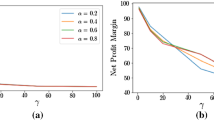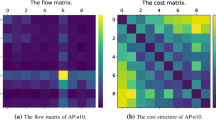Abstract
In this paper, we study the single allocation hub location problem with capacity selection in the presence of congestion at hubs. Accounting for congestion at hubs leads to a non-linear mixed integer program, for which we propose 18 alternate mixed integer second order conic program (MISOCP) based reformulations. Based on our computational studies, we identify the best MISOCP-based reformulation, which turns out to be 20–60 times faster than the state-of-the-art. Using the best MISOCP-based reformulation, we are able to exactly solve instances up to 50 nodes in less than half-an-hour. We also theoretically examine the dimensionality of the second order cones associated with different formulations, based on which their computational performances can be predicted. Our computational results corroborate our theoretical findings. Such insights can be helpful in the generation of efficient MISOCPs for similar classes of problems.

Similar content being viewed by others
References
Ahmadi-Javid, A., & Hoseinpour, P. (2017). Convexification of queueing formulas by mixed-integer second-order cone programming: An application to a discrete location problem with congestion. arXiv preprint arXiv:1710.05794.
Alkaabneh, F., Diabat, A., & Elhedhli, S. (2019). A Lagrangian heuristic and grasp for the hub-and-spoke network system with economies-of-scale and congestion. Transportation Research Part C: Emerging Technologies, 102, 249–273.
Alumur, S., & Kara, B. Y. (2008). Network hub location problems: The state of the art. European Journal of Operational Research, 190(1), 1–21.
Atamtürk, A., Berenguer, G., & Shen, Z. J. (2012). A conic integer programming approach to stochastic joint location-inventory problems. Operations Research, 60(2), 366–381.
Aykin, T. (1994). Lagrangian relaxation based approaches to capacitated hub-and-spoke network design problem. European Journal of Operational Research, 79(3), 501–523.
Azizi, N., Vidyarthi, N., & Chauhan, S. S. (2018). Modelling and analysis of hub-and-spoke networks under stochastic demand and congestion. Annals of Operations Research, 264(1–2), 1–40.
Bania, N., Bauer, P. W., & Zlatoper, T. J. (1998). Us air passenger service: A taxonomy of route networks, hub locations, and competition. Transportation Research Part E: Logistics and Transportation Review, 34(1), 53–74.
Boland, N., Krishnamoorthy, M., Ernst, A. T., & Ebery, J. (2004). Preprocessing and cutting for multiple allocation hub location problems. European Journal of Operational Research, 155(3), 638–653.
Campbell, J. F., & O’Kelly, M. E. (2012). Twenty-five years of hub location research. Transportation Science, 46(2), 153–169.
Contreras, I., Cordeau, J. F., & Laporte, G. (2012). Exact solution of large-scale hub location problems with multiple capacity levels. Transportation Science, 46(4), 439–459.
Contreras, I., Díaz, J. A., & Fernández, E. (2009). Lagrangean relaxation for the capacitated hub location problem with single assignment. OR Spectrum, 31(3), 483–505.
Contreras, I., Díaz, J. A., & Fernández, E. (2011). Branch and price for large-scale capacitated hub location problems with single assignment. INFORMS Journal on Computing, 23(1), 41–55.
Correia, I., Nickel, S., & Saldanha-da Gama, F. (2010). Single-assignment hub location problems with multiple capacity levels. Transportation Research Part B: Methodological, 44(8–9), 1047–1066.
Correia, I., Nickel, S., & Saldanha-da Gama, F. (2011). Hub and spoke network design with single-assignment, capacity decisions and balancing requirements. Applied Mathematical Modelling, 35(10), 4841–4851.
da Graça, C. M., Captivo, M. E., & Clímaco, J. (2008). Capacitated single allocation hub location problema bi-criteria approach. Computers & Operations Research, 35(11), 3671–3695.
Dan, T., & Marcotte, P. (2019). Competitive facility location with selfish users and queues. Operations Research, 67(2), 479–497.
de Camargo, R. S., de Miranda, J. G., & Ferreira, R. P. (2011). A hybrid outer-approximation/benders decomposition algorithm for the single allocation hub location problem under congestion. Operations Research Letters, 39(5), 329–337.
de Camargo, R. S., Miranda, G, Jr., Ferreira, R. P. M., & Luna, H. (2009a). Multiple allocation hub-and-spoke network design under hub congestion. Computers & Operations Research, 36(12), 3097–3106.
de Camargo, R. S., Miranda, G, Jr., & Luna, H. (2008). Benders decomposition for the uncapacitated multiple allocation hub location problem. Computers & Operations Research, 35(4), 1047–1064.
de Camargo, R. S., de Miranda, J. G., & Luna, H. P. L. (2009b). Benders decomposition for hub location problems with economies of scale. Transportation Science, 43(1), 86–97.
Dolan, E. D., & Moré, J. J. (2002). Benchmarking optimization software with performance profiles. Mathematical Programming, 91(2), 201–213.
Ebery, J., Krishnamoorthy, M., Ernst, A., & Boland, N. (2000). The capacitated multiple allocation hub location problem: Formulations and algorithms. European Journal of Operational Research, 120(3), 614–631.
Elhedhli, S., & Hu, F. X. (2005). Hub-and-spoke network design with congestion. Computers & Operations Research, 32(6), 1615–1632.
Elhedhli, S., & Wu, H. (2010). A lagrangean heuristic for hub-and-spoke system design with capacity selection and congestion. INFORMS Journal on Computing, 22(2), 282–296.
Ernst, A. T., & Krishnamoorthy, M. (1996). Efficient algorithms for the uncapacitated single allocation p-hub median problem. Location Science, 4(3), 139–154.
Ernst, A. T., & Krishnamoorthy, M. (1998). An exact solution approach based on shortest-paths for p-hub median problems. INFORMS Journal on Computing, 10(2), 149–162.
Ernst, A. T., & Krishnamoorthy, M. (1999). Solution algorithms for the capacitated single allocation hub location problem. Annals of Operations Research, 86, 141–159.
Farahani, R. Z., Hekmatfar, M., Arabani, A. B., & Nikbakhsh, E. (2013). Hub location problems: A review of models, classification, solution techniques, and applications. Computers & Industrial Engineering, 64(4), 1096–1109.
Günlük, O., & Linderoth, J. (2012). Perspective reformulation and applications. In Mixed integer nonlinear programming, Springer, pp. 61–89.
Hasanzadeh, H., Bashiri, M., & Amiri, A. (2018). A new approach to optimize a hub covering location problem with a queue estimation component using genetic programming. Soft Computing, 22(3), 949–961.
Jayaswal, S., & Vidyarthi, N. (2013). Capacitated multiple allocation hub location with service level constraints for multiple consignment classes. Technical report, Indian Institute of Management Ahmedabad, Research and Publication Department.
Jayaswal, S., & Jewkes, E. M. (2016). Price and lead time differentiation, capacity strategy and market competition. International Journal of Production Research, 54(9), 2791–2806.
Jayaswal, S., Jewkes, E., & Ray, S. (2011). Product differentiation and operations strategy in a capacitated environment. European Journal of Operational Research, 210(3), 716–728.
Jayaswal, S., Vidyarthi, N., & Das, S. (2017). A cutting plane approach to combinatorial bandwidth packing problem with queuing delays. Optimization Letters, 11(1), 225–239.
Kara, B. Y., & Tansel, B. C. (2000). On the single-assignment p-hub center problem. European Journal of Operational Research, 125(3), 648–655.
Kian, R., & Kargar, K. (2016). Comparison of the formulations for a hub-and-spoke network design problem under congestion. Computers & Industrial Engineering, 101, 504–512.
Klincewicz, J. G. (1998). Hub location in backbone/tributary network design: A review. Location Science, 6(1–4), 307–335.
Lüer-Villagra, A., & Marianov, V. (2013). A competitive hub location and pricing problem. European Journal of Operational Research, 231(3), 734–744.
Marianov, V., & Serra, D. (2003). Location models for airline hubs behaving as m/d/c queues. Computers & Operations Research, 30(7), 983–1003.
Marianov, V., Serra, D., & ReVelle, C. (1999). Location of hubs in a competitive environment. European Journal of Operational Research, 114(2), 363–371.
Marín, A. (2005). Formulating and solving splittable capacitated multiple allocation hub location problems. Computers & Operations Research, 32(12), 3093–3109.
Martín, J. C., & Román, C. (2003). Hub location in the south-Atlantic airline market: A spatial competition game. Transportation Research Part A: Policy and Practice, 37(10), 865–888.
McShan, S., & Windle, R. (1989). The implications of hub-and-spoke routing for airline costs. Logistics and Transportation Review, 25(3), 209.
Meier, J. F., & Clausen, U. (2017). Solving single allocation hub location problems on Euclidean data. Transportation Science, 52(5), 1141–1155.
O’kelly, M. E. (1986). The location of interacting hub facilities. Transportation Science, 20(2), 92–106.
O’kelly, M. E. (1987). A quadratic integer program for the location of interacting hub facilities. European Journal of Operational Research, 32(3), 393–404.
Oum, T. H., Zhang, A., & Zhang, Y. (1995). Airline network rivalry. Canadian Journal of Economics, 28, 836–857.
Rodríguez-Martín, I., & Salazar-González, J. J. (2008). Solving a capacitated hub location problem. European Journal of Operational Research, 184(2), 468–479.
Skorin-Kapov, D., Skorin-Kapov, J., & O’Kelly, M. (1996). Tight linear programming relaxations of uncapacitated p-hub median problems. European Journal of Operational Research, 94(3), 582–593.
Tiwari, R., Jayaswal, S., & Sinha, A. (2020). Alternate solution approaches for competitive hub location problems. European Journal of Operational Research, 290, 68–80.
Toh, R. S., & Higgins, R. G. (1985). The impact of hub and spoke network centralization and route monopoly on domestic airline profitability. Transportation Journal, 24, 16–27.
Vidyarthi, N., Jayaswal, S., Chetty, V. B. T., et al. (2013). Exact solution to bandwidth packing problem with queuing delays. Indian Institute of Management.
Vidyarthi, N., & Jayaswal, S. (2014). Efficient solution of a class of location-allocation problems with stochastic demand and congestion. Computers & Operations Research, 48, 20–30.
Author information
Authors and Affiliations
Corresponding author
Additional information
Publisher's Note
Springer Nature remains neutral with regard to jurisdictional claims in published maps and institutional affiliations.
Appendices
Appendix
SHLPCC for the SK-based model
For SK-based model, the flow variables \(x_{ikm}\) are replaced by path variables \(x_{ijkm}\), where \(x_{ijkm} = {\left\{ \begin{array}{ll} 1, &{}\text {if flows from }i\text { to }j\text { are routed via hub }k\text { and }m \\ 0, &{}\text {otherwise}. \end{array}\right. }\)
Definition of other variables and parameters remain same.
1.1 Two-subscripted capacity allocation variable
Here, \(F_{ijkm}=W_{ij}( \chi d_{ik}+\alpha d_{km}+ \delta d_{mj})\) is the total flow through path \(i-j-k-m\). (76) and (77) connect the assignment variables and path variables.
[SK-MISOCP1] (3)–(5), (7), (9)–(10), (12), (14)-(21), (37)–(39), (76)–(78)
[SK-MISOCP2] (3)–(5), (7), (9)–(10), (12), (14)–(21), (41)–(44), (76)–(78).
[SK-MISOCP3] (3)–(5), (7), (9)–(10), (12), (14)–(21), (41)–(43), (46), (76)–(78).
[SK-MISOCP4] (3)–(5), (7), (9)–(10), (12), (14)–(21), (41)–(43), (47), (49), (50), (76)–(78).
[SK-MISOCP5] (3)–(5), (7)–(10), (12), (14)-(21), (52)–(54), (56), (76)–(78).
1.2 Three-subscripted capacity allocation variable
- [SK-MISOCP6] :
- [SK-MISOCP7] :
- [SK-MISOCP8] :
- [SK-MISOCP9] :
OA method
1.1 EK-OA-2s: OA-based method for EK-2s
The auxillary variable \(L_{kl}\) and \(\rho _{k}\) which were defined as \(L_{kl} = \rho _{k} y_{kl}\) and \(\rho _{k}=\frac{ s_{k}}{1+s{k}}\), imply
Also, earlier results, \(\sum _{l} L_{kl} =\rho _{k} \quad \forall k\) , \(L_{kl} \le y_{kl} \quad \forall k,l\) and \({\sum _{i}\sum _{j} W_{ij} z_{ik}} = \sum _{l} \gamma ^l_{k} L_{kl}\), remain. The function, \(L_{kl} = \frac{s_{k}}{(1+s_{k})}\) is a concave function which can be approximated with piecewise linear functions that are tangent to the function \(L_{kl}\) . The method chooses the minimum of these tangents at points \( s^h_{k} \quad \forall h \in H , {k} \, \in {N} , \,{{l}} \in {L}\). The cuts are given by
In the OA-based method proposed by Elhedhli and Hu (2005), for every \(k-l\) pair, the non linear congestion term is approximated with tangents (cuts), given by (82), at points \(s_{k}^h\) (set at \(h_{0}\) initially). At every iteration a relaxed mixed integer linear problem is solved. The solution of which not only gives the lower bound but also supplies information for the next cut. Also, this solution is feasible for the main problem thus giving the upper bound. The algorithm terminates when both upper and lower bounds are \(\epsilon \) (or less) away from each other where \(\epsilon \ge 0\). Günlük and Linderoth (2012) proposed perspective counterpart for (83) as
and the corresponding perspective cut at \(s_{k}^h\) as
The formulation for the EK-OA-2s is as follows:
Algorithm for the above discussed OA-based method is as follows:

1.2 EK-OA-3s: OA-based method for EK-3s
For formulations with \(t^{l}_{ik}\), we had objective function as
We introduce variable \(\rho _{kl}\) and \(s_{kl}\) such that
\(\rho _{kl}\) and \(s_{kl}\) are related as
which is non-linear concave function and can be approximated using tangent hyperplanes as discussed in the previous section. For perspective reformulation, we introduce the following constraint
to the following equivalent perspective form
By following logic similar to (83), we have perspective cuts as
The overall formulation for the approximation method is as follows:
Algorithm for the above discussed OA-based method is as follows:

Performance profile for coefficient of variation (c), and unit congestion cost \(\theta \) for CAB dataset
Rights and permissions
About this article
Cite this article
Dhyani Bhatt, S., Jayaswal, S., Sinha, A. et al. Alternate second order conic program reformulations for hub location under stochastic demand and congestion. Ann Oper Res 304, 481–527 (2021). https://doi.org/10.1007/s10479-021-03993-6
Accepted:
Published:
Issue Date:
DOI: https://doi.org/10.1007/s10479-021-03993-6






